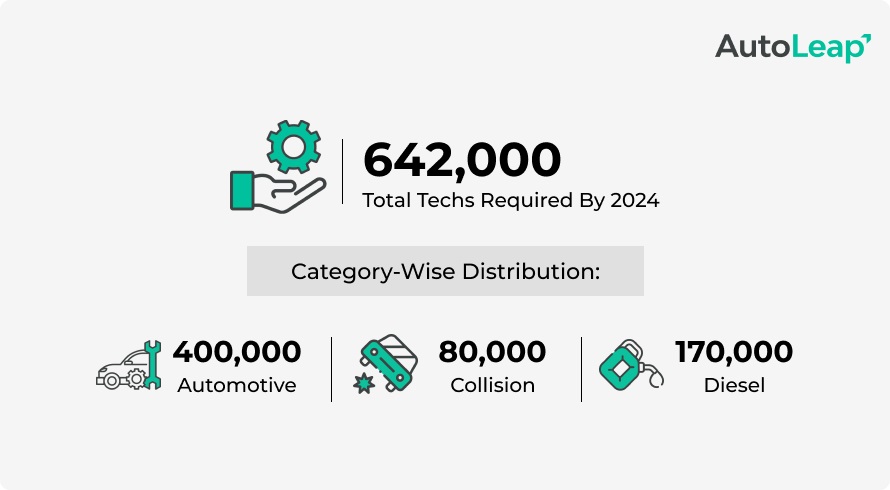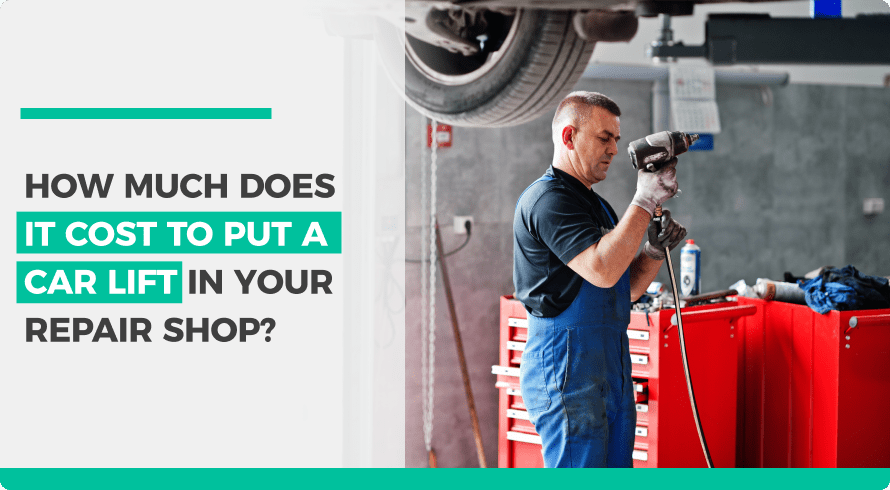These days, auto repair shops can fix and service almost any vehicle. But there’s one challenge that’s proving to be a real headache—the automotive technician shortage. In fact, according to a 2020 study by TechForce Foundation, the statistics are grim. The study cites that the US auto repair industry will be short almost 642,000 techs between 2020 and 2024.
While the numbers definitely look bad, there are ways to effectively deal with the situation. In order to run your business, you need installers, diagnosticians, service technicians, specialists, service writers, and managers who are skilled and ready to work. Where are all of these professionals?
New vehicle technology is changing the market
Let’s look at some of the reasons behind the shortage, which industry analysts have been warning about for some time. Baby-boomer technicians are retiring in droves, almost 9% every year. National Auto Dealers Association (NADA, which recently launched an initiative to encourage tech careers) shows that B-Technicians at dealerships are turning over at about 31% yearly. There are fewer techs graduating with post-secondary automotive degrees—just 5,105 in 2018.
It’s not just independent repair shops; service departments at dealerships, national repair chains, the fleet industry, and others in the auto repair industry are also feeling the pinch. “New vehicle technology is improving vehicle safety and operating efficiency with each model-year, but requires advanced technical skills, more expensive shop equipment, and additional steps in diagnostic and repair processes,” says Kelly Hatlee, of Enterprise Fleet Management. The supply shortage created as a result of the increasing technology is apparent from the employment opportunities created in the market.

How do you start fixing the problem? Maybe, with the potential recruits—automotive students.
Adjusting to the needs of auto tech students
There have been recent initiatives to increase the supply of techs in the auto repair industry.
One of the solutions to the problem is coming from the automotive educational providers themselves. Many automotive programs are trying to adjust to the needs of students by providing options. For example, Broward College in Florida offers a number of dealer-specific automotive programs for students, combining academic and automotive classes. In just two years, graduates receive an Associate of Applied Science (AAS) degree. There’s also an advanced-level program, a master technical program for ASE-certified techs who can apply their work experience towards an AAS degree.
Perhaps one of the solutions is increasing diversity within the sector. And leading the charge is an innovative partnership between Advance Auto Parts Foundation and Wake Technical Community College. Advance Auto Parts has made a $200,000 commitment and partnership with Wake to increase student diversity in the college’s auto systems technology and collision repair programs. Advance Auto Parts is also donating $50,000 to fund the school’s tool rooms in support of student learning.
Wondering what you can do right now to ensure you’re not caught short-handed? Here are a few tips!
Tip #1: Invest in tools and technology
A technician’s toolbox is one of the most important things they own. But the reality is, there’s a significant cost to acquire a good set of brand-name wrenches and ratchets.
Some shops will provide specialty tools and maybe even basic ones. But in the face of the current shortage, shop owners could provide tools to technicians and sweeten the deal for new hires. Rather than requiring apprentices and junior techs to spend their own money on tools, shops could provide tool purchase assistance. That way, techs can walk into the service bay better prepared to take on their work.
As it is, shops are investing heavily in diagnostic equipment even to perform the most basic vehicle maintenance. With the advancements in vehicle technology, techs need access to the right equipment to comply with manufacturer standards for accurate and safe repairs.
When trying to attract millennial and Gen Z recruits, a high-tech environment can be a bonus. This generation is digital native—having grown up surrounded by technology, they’re naturally better at working with computers. With the world growing increasingly digital, several questions come up—do you have robust auto shop management software? Does your business have a website and social media presence? Digital vehicle inspections? All of these factors come together to make your repair shop the best in the region and most attractive for new recruits.
Tip #2: Foster a healthy culture
Retaining the techs you have is one of the most effective ways to combat the auto repair tech shortage. Fostering the right kind of culture in your shop can help attract and keep the best talent. Dealers already know this and provide all the latest software, regular training, benefits, and financial incentives, like referral fees, not only to their techs but to their service managers and writers as well. Millennials, in particular, want a better work-life balance, and benefits matter. Some shops make a point of offering time for family, mentorship programs, and regular training.
Additionally, with technology like Predictive Maintenance (PdM) among others becoming central to today’s auto repair, teaching your technicians the latest techniques is important. Doing so not only boosts productivity at your shop but also allows your employees to learn new skills, leading to greater job satisfaction and a sense of progression. Provide regular training during hours that don’t infringe on their personal time or take away from their shop hours and earnings.
Tip #3: Offer attractive compensation packages to techs
It’s important to compensate your techs according to industry norms. Most shops run at a flat rate, but times are changing. Should your valuable techs only get paid for the work they do?
If a job gets quoted at four hours but actually takes six hours to complete, the tech eats the lost time. You might want to review your numbers and see if raising your labor rate is feasible. Techs want to have a career, not just a job with a paycheck. Invest in your techs, and you just may find your service bays humming with good people and productivity.
According to Indeed, the average base salary for automotive technicians in the US is approximately $22 per hour. More skilled and experienced techs would charge higher, but they’ll likely be able to service more complex problems. It’s easier to find the right talent if your business is forward-thinking and uses a mechanic shop software, since technicians and service advisors have to do fewer redundant tasks.
Conclusion
There’s an undisputable shortage of qualified techs in the industry. It’s coming at a time when vehicles are getting more complicated every day, with more stringent repair requirements from manufacturers. However, the sector is stepping up. From our industry associations to educational institutions to shop owners, everyone is thinking outside the service bay. There are candidates with the relevant skills and experience in the market. It all comes down to how you attract the relevant talent and provide an environment that ensures they remain loyal to your shop.
No. You can become a mechanic with a high school degree. But specializations and certifications, specifically the ASE-certification, will help you grow your earning potential.
Mechanic labor is costly for many reasons. One primary reason is the widespread shortage of quality technicians available for hire. These technicians are in high demand, raising the salary expectations for this position.
There are many reasons for the automotive technician shortage. Some causes include:
- Baby-boomer technicians retiring
- Fewer techs graduating with post-secondary automotive degrees
- Reduced emphasis on trades in high school education
- Stigmas surrounding the profession
Automotive mechanics are in high demand. Technicians with advanced specializations and ASE certifications can earn impressive salaries, as many US shops value these credentials.
Yes. There is a significant shortage of automotive technicians. It is one of the most pressing issues the industry faces today.
Auto Repair Shop Management Software
AutoLeap is a powerful all-in-one auto repair shop software that helps to keep complete track of your business – from scheduling appointments to managing technicians and generating invoices.


 Demo
Demo


